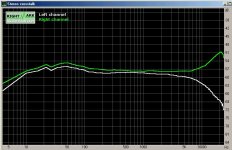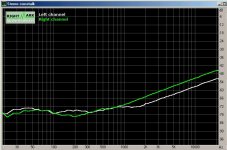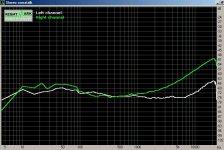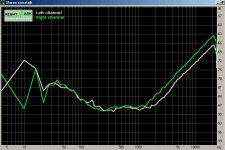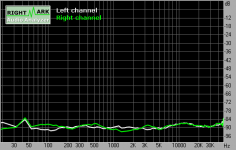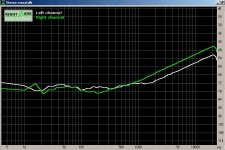This is the image of crosstalk result from tests on my power amp (actually a Technics stereo receiver) using RMAA. Notice how after about 5-6Khz the crosstalk increases on the left channel but decreases on the right channel. Why is it happening so ?
I would expect the crosstalk to increases or decrease on BOTH channels not go in opposite directions as is shown in the picture.
I would expect the crosstalk to increases or decrease on BOTH channels not go in opposite directions as is shown in the picture.
Attachments
A- Have you run a basic loop-back to be sure your soundcard and connections are not at fault? I have found that those 3.5mm mico phono plugs that you have to use with soundcards can be a source of priblems -- including crosstalk. Some are better than others -- it seems random.
B- measure the resistance of the two resistors, then of the resistors plus the wiring connected to them. Be sure they are the same for both channels.
C- swap the left/right connections at each stage to be sure the problem remains in the left channel of the amp and does not depend on the test setup connections.
D- be sure the soundcard mixer software has disabled all the effects and "features".
I'm mentioning all this because I've found that wierd results can sometimes be attributable to the set up glitches. I one spent a couple of days looking for high distortion in an amp when the real problem was in the soundcard.
B- measure the resistance of the two resistors, then of the resistors plus the wiring connected to them. Be sure they are the same for both channels.
C- swap the left/right connections at each stage to be sure the problem remains in the left channel of the amp and does not depend on the test setup connections.
D- be sure the soundcard mixer software has disabled all the effects and "features".
I'm mentioning all this because I've found that wierd results can sometimes be attributable to the set up glitches. I one spent a couple of days looking for high distortion in an amp when the real problem was in the soundcard.
sam9 said:
I'm mentioning all this because I've found that wierd results can sometimes be attributable to the set up glitches.
That was probably it. The connections to the resistors from the output terminals were probably goofing up things. I re-did them and the measurements make more sense now. Here is the crosstalk of the amp now -
Attachments
Its a Turtle Beach Santa Cruz.
This is a good place for a few sound card comparisons and test measurements - http://www.pcavtech.com/soundcards/compare/index.htm
I have the results of all the tests that RMAA can do, not sure if I should dump them in this thread or not. But I can send a .sav file that can open in RMAA and show all results, or pics, to anyone who is interested.
This is a good place for a few sound card comparisons and test measurements - http://www.pcavtech.com/soundcards/compare/index.htm
I have the results of all the tests that RMAA can do, not sure if I should dump them in this thread or not. But I can send a .sav file that can open in RMAA and show all results, or pics, to anyone who is interested.
Hi Percy,
it may well be that the differences displayed on loopback between channels could be exacerbated when operated into the different impedances of the test amplifier.
Your crosstalk is not good - what is the composition? My last commercial amplifier had 91dB channel seperation - at 20KHz, using a common power supply. At 91dB + the composition doesn't really matter.
Cheers,
Greg
it may well be that the differences displayed on loopback between channels could be exacerbated when operated into the different impedances of the test amplifier.
Your crosstalk is not good - what is the composition? My last commercial amplifier had 91dB channel seperation - at 20KHz, using a common power supply. At 91dB + the composition doesn't really matter.
Cheers,
Greg
I get a little lower X-talk on my SC card with the loop-back, but not much.
I think you have to subtract the loop-back figures from the amplfier's graph. A pain in the neck and not very exact depending on how accuratly you can read the values off with a ruler. I would just look atn the 1k and 10k points. RightMark has no function to do this for you -- you can't even get a data file from the graph.
This assumes cross talk is cummulative. If not, someone let me know please, so I don't get led astray.
I think you have to subtract the loop-back figures from the amplfier's graph. A pain in the neck and not very exact depending on how accuratly you can read the values off with a ruler. I would just look atn the 1k and 10k points. RightMark has no function to do this for you -- you can't even get a data file from the graph.
This assumes cross talk is cummulative. If not, someone let me know please, so I don't get led astray.
Hi Sam,
In an ideal world crosstalk would be simply the level of identical frequency to the test frequency in the other channel. But often the measurement is of everything coming out of the other channel while one is swept so it includes all manner of nasty PS artefacts, hum, noise and, of course, pure crosstalk.
Accordingly it is difficult to come to any conclusion as to addition or subtraction. Add the log reading for complexity.
Cheers,
Greg
In an ideal world crosstalk would be simply the level of identical frequency to the test frequency in the other channel. But often the measurement is of everything coming out of the other channel while one is swept so it includes all manner of nasty PS artefacts, hum, noise and, of course, pure crosstalk.
Accordingly it is difficult to come to any conclusion as to addition or subtraction. Add the log reading for complexity.
Cheers,
Greg
Hi Percy,
One thing that I found was causing very poor crosstalk results for me was "ground leakage" I put that in quotes because that is the best way I can think of describing it..... basically I had to put some low value resistors in the ground lines of my test probes, once I did this the crosstalk figures improved dramatically (from around 40db to around 80db). What tipped me off in the end was that the crosstalk was good when I used a cd (with the rmaa test tones on it) and bad when I used the pc soundcard for both output and input I wanted to use the pc for output as I could use 96Khz which I can't with my DVD player. from memory I used 6.8 ohm resistors.
I wanted to use the pc for output as I could use 96Khz which I can't with my DVD player. from memory I used 6.8 ohm resistors.
what I think was happening was that the speaker return was partially going back to the amp and partially going through the sound card and out to earth...
here is a link to the tests I did on my Audigy II ZS if interested --> http://home.people.net.au/~tonywww/rmaa/audigy2ZS 96Khz.htm
Tony.
One thing that I found was causing very poor crosstalk results for me was "ground leakage" I put that in quotes because that is the best way I can think of describing it..... basically I had to put some low value resistors in the ground lines of my test probes, once I did this the crosstalk figures improved dramatically (from around 40db to around 80db). What tipped me off in the end was that the crosstalk was good when I used a cd (with the rmaa test tones on it) and bad when I used the pc soundcard for both output and input
what I think was happening was that the speaker return was partially going back to the amp and partially going through the sound card and out to earth...
here is a link to the tests I did on my Audigy II ZS if interested --> http://home.people.net.au/~tonywww/rmaa/audigy2ZS 96Khz.htm
Tony.
Hi percy !
I am sorry to be rude, but your soundcard is not really "decent"...
I suggest that if you want to do more measurements to get a more
sophisticated soundcard !
I attached the crosstalk from the soundcard i am using now, it is
a "m-audio delta 2496", not too expensive and not built for gamers...
Have you verified that your loopback-cable is not defect/unshielded ?
Full report:
http://www.lf-pro.net/mbittner/rmaa/M-Audio_32b96.htm
Mike
I am sorry to be rude, but your soundcard is not really "decent"...
I suggest that if you want to do more measurements to get a more
sophisticated soundcard !
I attached the crosstalk from the soundcard i am using now, it is
a "m-audio delta 2496", not too expensive and not built for gamers...
Have you verified that your loopback-cable is not defect/unshielded ?
Full report:
http://www.lf-pro.net/mbittner/rmaa/M-Audio_32b96.htm
Mike
Attachments
amplifierguru said:Your crosstalk is not good - what is the composition? My last commercial amplifier had 91dB channel seperation - at 20KHz, using a common power supply. At 91dB + the composition doesn't really matter.
Cheers,
Greg
Is that under load or no load condition ? and at what power ?
I was operating at about 3W rms into a 5-ohm resistor. Maybe my amplifier vocabulary is bad but not sure what you mean by composition. Its a Technics Stereo Receiver - basically a chip amp with Class H+ configuration.
This is a pic of the no-load xtalk. Its better than the one under load.
This brings up another question - is it normal for xtalk to increase under load ? And this is a very light load as compared to what it can take (100W into 8ohm, I know it is 4ohm stable).
edit:- Note that it is following the trajectory of the soundcard's xtalk.
Attachments
percy said:Its a Turtle Beach Santa Cruz.
This is a good place for a few sound card comparisons and test measurements - http://www.pcavtech.com/soundcards/compare/index.htm
It doesn't look like the measurements include many currently-available cards. If anyone knows a more up-to-date series of tests, I'm highly interested.
If anyone knows a more up-to-date series of tests, I'm highly interested
and what better place than this(diyaudio.com)!
If you think it makes sense then you could start a thread(sticky ?) in the Digital forum and let people throw their test results in it for the newer cards. I am sure there are many people over there with the type of cards you are looking for and also have test
results already available.
Hmmm,
After i realized that i have to upgrade my win2k to sp4 to have real 24bit,
i updated the measurement for my soundcard...
I think for 90Euro a good choice for doing measurements !
See yourself:
http://www.lf-pro.net/mbittner/rmaa/M-Audio_Delta_24_96.htm
Mike
After i realized that i have to upgrade my win2k to sp4 to have real 24bit,
i updated the measurement for my soundcard...
I think for 90Euro a good choice for doing measurements !
See yourself:
http://www.lf-pro.net/mbittner/rmaa/M-Audio_Delta_24_96.htm
Mike
percy said:
and what better place than this(diyaudio.com)!
If you think it makes sense then you could start a thread(sticky ?) in the Digital forum and let people throw their test results in it for the newer cards. I am sure there are many people over there with the type of cards you are looking for and also have test
results already available.
not a bad idea, but would have to have some rules
Tony.
but would have to have some rules ie standardised version of RMAA and standardised settings for the test, otherwise everyone could use different versions/settings and it would be impossible to make real comparisons the things you couldn't standardise are things like the cable used, OS, other pc hardware etc, so even with the above there could be
There are a few even more fundamental things to work out. I've made a few loop-back tests with RightMark and the issues regarding choice of wires and versions are a ways down the page on my list of issues. Among the things to be considered is how to get comparable and reproducable results when the mixer software is different for each card and when the ability to set the mixer sliders exactly the same way twice with your mouse is dubious. Very small changes in mixer position seem to make really big differences.
One thing I have not done yet but I suspect is important is to use a buffer in the loop-back. I say this because my impression is that some cards (I include Santa Cruz in this) don't seem to have matched the impedances of the output and input jacks well. Why should they? They werre not designed for that. As an exaple the Santa Cruz (again) seems to benefit from something a simple as a few k-ohms of resistance added to the loop back. This suggests to me that the card's output can barely derive it's input. Again, why should it?
After some of these proceedures are worked out, then that's the time for fine tuning.
- Status
- This old topic is closed. If you want to reopen this topic, contact a moderator using the "Report Post" button.
- Home
- Amplifiers
- Solid State
- Strange Crosstalk result
